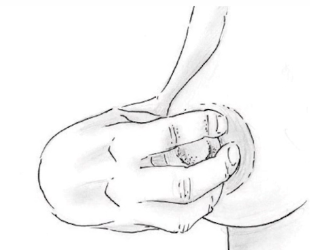Hard, swollen breasts? Find out what causes engorgement and how to relieve the pain

It is quite normal for breasts to become larger and feel heavy, warmer and uncomfortable when your breastmilk supply increases, often about 2 to 5 days after your baby is born.
However, in some cases, a mum’s breasts can become very hard, swollen and tender and her nipples become stretched and flattened. The milk may not flow well and it may be difficult for her baby to attach to the breast. This is called engorgement.
Engorgement happens in both breasts at the same time. It can involve the whole breast, even under the armpit.
In the first few days
Before your milk starts quickly increasing in volume:
- Keep your baby close from birth, skin-to-skin if possible and breastfeed them often.
- Let your baby feed for as long as they want to each time you breastfeed them.
- Hold your baby comfortably so they can attach well and remove milk.
- Start each feed on alternate breasts so each is stimulated.
- Express if your baby is not yet feeding at the breast.
Relieving engorgement
Here are some things you can try:
Go without a bra or take it off -before beginning to breastfeed.
Very gently stroke your breasts towards the nipple or or apply gentle warmth before feeds to help your milk flow.
Use cool packs between feeds to reduce inflammation.
Wake your baby for a feed if your breasts become full and uncomfortable especially during the night.
If necessary, hand express for comfort after feeds.
Common anti-inflammatory medication or pain relief medications can be helpful. Talk to your midwife or doctor about your options.
Continue to breastfeed your baby as often as they need.
If your engorgement is severe, and the information here hasn’t helped, ask your midwife or a lactation consultant for help as soon as possible.
Helping your baby attach
Your baby may have difficulty attaching if your breasts are swollen and your nipple is flatter than usual. In this case it is helpful to soften the area around your nipple.
Try expressing some milk by hand or with a pump.
Use a simple technique called ‘reverse pressure softening’.
What is reverse pressure softening?
Reverse pressure softening1 can be used to push back the fluid that has built up behind and around your nipple and relieve the pressure. The breast tissue then becomes softer, allowing your baby to attach more easily. There are a few different ways you can reverse the pressure.
Read the following descriptions and watch the video below to see the technique in action.
'Reverse pressure softening' to soften overfull breasts before feeding or expressing
This works best when you are lying on your back.

2-handed 1-step method
With fingernails short and fingertips curved, push in with each one touching the side of the nipple. Hold for 1-3 minutes or more until the tissue softens.

2-handed 2-step method
Use 2 or 3 straight fingers on each side, first knuckles touching the nipple. Push in and hold for 1-3 minutes or more. Repeat above and below the nipple.

1-handed 'flower hold'
With fingernails short and fingers curved, push in around the nipple in a circle. Hold for 1-3 minutes or more. A hand mirror may help you see your areola more easily.
Is your baby older than 6 weeks?
You can get symptoms similar to engorgement beyond the first 6 weeks if one or both of your breasts become very full. This may happen if:
- your baby goes longer between feeds or feeds for less time.
- they sleep for longer.
- they wean too quickly.
You can relieve overfull breasts by feeding your baby or by hand expressing some milk to soften your breast. Some of the tips above may also be helpful.
If your breasts continue to fill up quickly after feeds, it may be taking a little longer than usual for them to match your baby’s needs. You may have an oversupply.
Illustrations by Kyle Cotterman.
© Australian Breastfeeding Association June 2025
Whether you're preparing to breastfeed or already started the journey
Learn how to prevent engorgement
Breastfeeding Preparation Session - online and interactive

Your guide for navigating the first 72 hours with your newborn. Free for Virtual Village members.
The first 72 hours - eModule

Online interactive session free for Virtual Village members
Newborn Virtual Village - Comfortable attachment

Cotterman, K. J. (2004). Reverse pressure softening: A simple tool to prepare the areola for easier latching during engorgement. Journal of Human Lactation 20(2), 227–237.
Mitchell, K. B., Johnson, H. M., Rodríguez, J. M., Eglash, A., Scherzinger, C., Zakarija-Grkovic, I., Cash, K. W., Berens, P., Miller, B., & Academy of Breastfeeding Medicine (2022). Academy of Breastfeeding Medicine Clinical Protocol #36: The Mastitis Spectrum, Revised 2022. Breastfeeding Medicine, 17(5), 360–376.
Zakarija-Grkovic, I., & Stewart, F. (2020). Treatments for breast engorgement during lactation. The Cochrane Database of Systematic Reviews, 9(9), CD006946.








